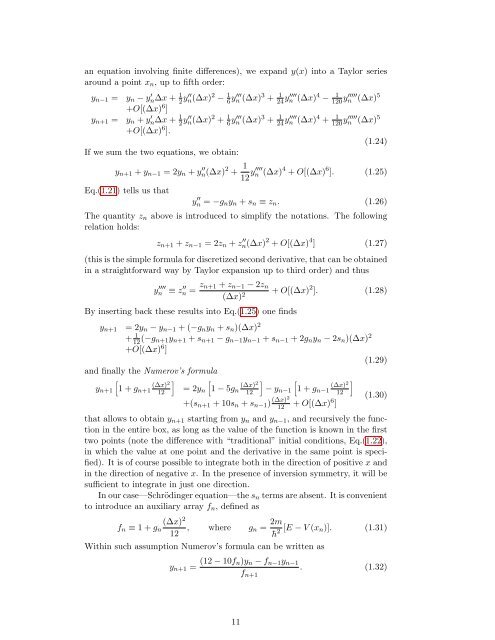Numerical Methods in Quantum Mechanics - Dipartimento di Fisica
Numerical Methods in Quantum Mechanics - Dipartimento di Fisica
Numerical Methods in Quantum Mechanics - Dipartimento di Fisica
Create successful ePaper yourself
Turn your PDF publications into a flip-book with our unique Google optimized e-Paper software.
an equation <strong>in</strong>volv<strong>in</strong>g f<strong>in</strong>ite <strong>di</strong>fferences), we expand y(x) <strong>in</strong>to a Taylor series<br />
around a po<strong>in</strong>t x n , up to fifth order:<br />
y n−1 =<br />
y n+1 =<br />
y n − y n∆x ′ + 1 2 y′′ n(∆x) 2 − 1 6 y′′′ n (∆x) 3 + 1<br />
+O[(∆x) 6 ]<br />
y n + y n∆x ′ + 1 2 y′′ n(∆x) 2 + 1 6 y′′′ n (∆x) 3 + 1<br />
+O[(∆x) 6 ].<br />
If we sum the two equations, we obta<strong>in</strong>:<br />
24 y′′′′<br />
24 y′′′′<br />
n (∆x) 4 − 1<br />
n (∆x) 4 + 1<br />
120 y′′′′′<br />
120 y′′′′′<br />
n (∆x) 5<br />
n (∆x) 5<br />
(1.24)<br />
y n+1 + y n−1 = 2y n + y ′′<br />
n(∆x) 2 + 1<br />
12 y′′′′ n (∆x) 4 + O[(∆x) 6 ]. (1.25)<br />
Eq.(1.21) tells us that<br />
y n ′′ = −g n y n + s n ≡ z n . (1.26)<br />
The quantity z n above is <strong>in</strong>troduced to simplify the notations. The follow<strong>in</strong>g<br />
relation holds:<br />
z n+1 + z n−1 = 2z n + z ′′<br />
n(∆x) 2 + O[(∆x) 4 ] (1.27)<br />
(this is the simple formula for <strong>di</strong>scretized second derivative, that can be obta<strong>in</strong>ed<br />
<strong>in</strong> a straightforward way by Taylor expansion up to third order) and thus<br />
y ′′′′<br />
n ≡ z ′′<br />
n = z n+1 + z n−1 − 2z n<br />
(∆x) 2 + O[(∆x) 2 ]. (1.28)<br />
By <strong>in</strong>sert<strong>in</strong>g back these results <strong>in</strong>to Eq.(1.25) one f<strong>in</strong>ds<br />
y n+1 = 2y n − y n−1 + (−g n y n + s n )(∆x) 2<br />
+ 1<br />
12 (−g n+1y n+1 + s n+1 − g n−1 y n−1 + s n−1 + 2g n y n − 2s n )(∆x) 2<br />
+O[(∆x) 6 ]<br />
(1.29)<br />
and f<strong>in</strong>ally the Numerov’s formula<br />
[<br />
] [<br />
] ]<br />
(∆x)<br />
y n+1 1 + g 2<br />
(∆x)<br />
n+1 = 2y n 1 − 5g 2<br />
(∆x)<br />
n − y n−1<br />
[1 + g 2<br />
n−1<br />
12<br />
12<br />
+(s n+1 + 10s n + s n−1 ) (∆x)2<br />
12<br />
+ O[(∆x) 6 ]<br />
12<br />
(1.30)<br />
that allows to obta<strong>in</strong> y n+1 start<strong>in</strong>g from y n and y n−1 , and recursively the function<br />
<strong>in</strong> the entire box, as long as the value of the function is known <strong>in</strong> the first<br />
two po<strong>in</strong>ts (note the <strong>di</strong>fference with “tra<strong>di</strong>tional” <strong>in</strong>itial con<strong>di</strong>tions, Eq.(1.22),<br />
<strong>in</strong> which the value at one po<strong>in</strong>t and the derivative <strong>in</strong> the same po<strong>in</strong>t is specified).<br />
It is of course possible to <strong>in</strong>tegrate both <strong>in</strong> the <strong>di</strong>rection of positive x and<br />
<strong>in</strong> the <strong>di</strong>rection of negative x. In the presence of <strong>in</strong>version symmetry, it will be<br />
sufficient to <strong>in</strong>tegrate <strong>in</strong> just one <strong>di</strong>rection.<br />
In our case—Schröd<strong>in</strong>ger equation—the s n terms are absent. It is convenient<br />
to <strong>in</strong>troduce an auxiliary array f n , def<strong>in</strong>ed as<br />
(∆x) 2<br />
f n ≡ 1 + g n<br />
12 , where g n = 2m<br />
¯h 2 [E − V (x n)]. (1.31)<br />
With<strong>in</strong> such assumption Numerov’s formula can be written as<br />
y n+1 = (12 − 10f n)y n − f n−1 y n−1<br />
f n+1<br />
. (1.32)<br />
11
















